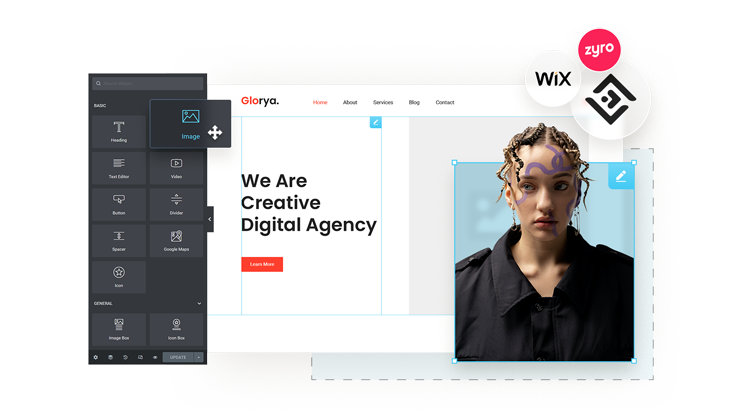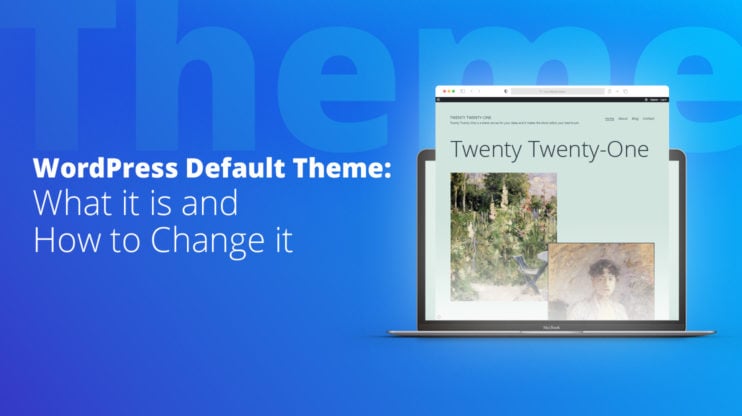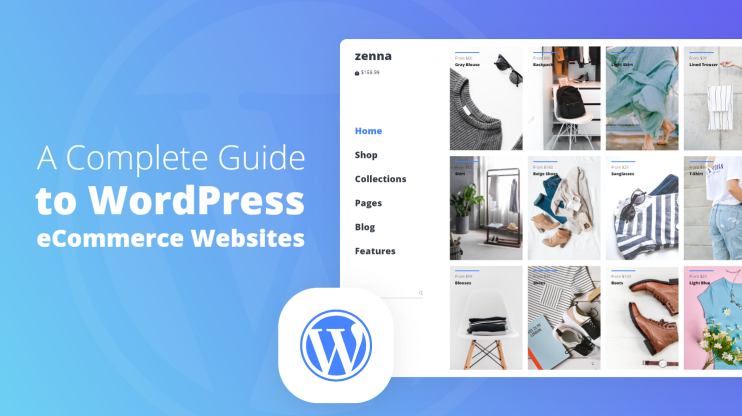Starting your own clothing brand sounds exciting, until you actually try to do it. Suddenly, you’re hit with questions like: Do I need to register a business? What platform should I use? How do I find suppliers, or do I even need them? Can I start this with just $500?
Most first-time founders feel overwhelmed by all the unknowns. But the global retail ecommerce market is massive, over $7.4 trillion, and there’s room for you, too. You don’t need to know everything about how to start a clothing business online. You just need to take the right first steps, in the right order.
This guide is for anyone who has a vision for a clothing brand but isn’t sure how to turn that idea into something real. Maybe you’ve sketched a few designs, have a style you believe in, or built a moodboard that captures your aesthetic. Maybe you’ve already chosen a name and launched an Instagram, but haven’t made your first sale yet. No matter where you are, this article will walk you through the essentials:
- How to define your brand and choose a business model
- What to spend your money on (and what to skip)
- The tools and platforms that make store setup easier
- How to get your first products live, and your first customers through the door
We’ll also share some real problems, as well as their solutions from experienced entrepreneurs, who’ve seen what works. So take a breath. You don’t need a fashion degree, a warehouse full of inventory, or a huge budget to get started. You just need a plan. Let’s build one.
1. Define your vision: What are you building and why?
Before you design your first product or choose a platform, take a step back. Your brand has a story, vibe, and purpose behind it. That’s what makes people connect. That’s what makes them buy.
Let’s take a cue from one of the best. Think about Nike. They don’t just sell sneakers. They empower people to reach their fitness goals. Their slogan, “Just do it,” isn’t just catchy – it’s integrated in everything they create, from their ads to their athlete collaborations. That message is the foundation of their brand.
You should have one, too. In fact, figuring out your brand identity is one of the most overlooked steps in learning how to start a clothing business online. Start by answering a few core questions:
- Who are you creating for? Are you designing for Gen Z streetwear fans, or new moms looking for stylish comfort?
- What do you want your brand to stand for? Think beyond fashion. Are you about sustainability, self-expression, cultural roots, comfort, rebellion, or all of the above?
- Why are you doing this? Your “why” gives your brand soul. It doesn’t have to be deep, just honest. Maybe you couldn’t find clothes that fit your body. Maybe you’re turning a creative outlet into a career. Maybe you just love making people feel confident.
You obsess over finding the perfect answers right away. But getting clear on your audience and your purpose will make the rest so much easier, from choosing products to writing your About page to posting on TikTok. Take your time here. Your brand identity is the foundation for everything else you’re about to build.
Insider tip: If you can describe your brand in one sentence, you’re on the right track. It could be something like “streetwear for introverts who love minimal design.”
2. Choose the right business model
Let’s discuss the business side of things. Before you even know what you sell, we need to figure out how you want to sell it. There are three main business models for beginners. Each has trade-offs, especially when money is tight:
| Aspect | Print-on-demand (POD) | Buy inventory (bulk/custom) | Pre-orders / crowdfunding |
| Upfront cost | $0–$500 | $500–$3,000+ | $100–$500 (for samples, mockups, basic store setup) |
| Profit margin | Low–Medium | High | Medium |
| Control | Limited (no packaging control, slower shipping) | Full (product quality, shipping, packaging, branding) | Medium (control product, but not cash flow timing) |
| Fulfillment | Done by provider | You ship or use a third-party logistics (3PL) service | Fulfilled after orders come in (you still handle it later) |
So, which model should you start with?
- If you’re just testing the waters, print-on-demand is usually the safest play. It’s ideal if you want to get your brand out there quickly without the stress (or cost) of inventory. Just know that margins are lower, so you’ll need to focus on great branding and smart marketing to stand out.
- If you have a strong product idea, some savings, and want full control over packaging, shipping, and quality, buying inventory gives you more freedom and higher profit potential. Just make sure you’ve validated your idea first, because unsold inventory ties up your cash.
- If you’re somewhere in between, or you already have a small following, pre-orders or crowdfunding can help you launch without taking on risk. You’ll need to communicate clearly with buyers and manage delivery timelines, but it’s a solid way to prove people want what you’re offering before you spend big.
Figuring out which of these models fits you is a key part of how to start a clothing business online. Each path has pros and cons, but what matters most is choosing one that fits your stage, budget, and appetite for risk. You can always evolve later.
3. Create your brand
After finding your business model, it’s time to make your brand feel like a brand. Your brand is how you make people feel the moment they land on your website or see your product. And that emotional connection is what turns casual visitors into loyal customers. To create this unique feeling, you use your name, logo, color scheme, specific messaging, and more.
You might be tempted to find a full-on branding agency to figure this out, but all you need is clarity and consistency for the beginning. Here’s a simple checklist to shape your brand identity:
- Start with your vibe: Think about the feeling behind your brand. Is it minimal and clean? Loud and expressive? Soft and cozy? Choose 2–3 words that define your style and let that guide your visuals, copy, and product design.
- Keep your visuals consistent: Choose one or two main colors, a clear font, and a photo style that fits your vibe. Don’t worry about fancy logos, just create something simple and recognizable.
- Find your voice: How do you want to sound? Chill and friendly? Minimal and polished? Your tone should come through in everything from product descriptions to Instagram captions.
- Know your “why”: You don’t need a big mission statement. Just a real reason. Maybe you’re solving a problem you faced, or creating for a community you’re part of. That honesty is what makes your brand relatable.
- Make sure it all fits together: Your vibe, visuals, voice, and message should feel like one story. If your Instagram feed, website, and product mockups all give off the same energy, you’re on the right track.
Even if you’re only launching with one product, a clear brand identity will make it feel like a brand, not just a project.
There are a lot of free branding tools you can use to test your ideas, like 10Web’s Business Name Generator, Slogan Generator, or even Vision Statement Generator.
4. Budget smart: What to spend and what to skip
When you’re launching your brand with limited funds, the pressure to spend wisely is real. It’s easy to fall into the trap of buying everything upfront – custom packaging, pro logo design, bulk inventory. But most of it can wait.
Here’s how to stretch your budget and focus on what actually helps you launch:
- Skip expensive branding and packaging, for now: A $500 logo or custom boxes won’t help you get your first sale. You can use some solid free tools. We’ll discuss them below.
- Focus on product presentation: Invest in high-quality mockups or basic product photography. People can’t touch your clothes online, so visuals help to build the initial trust.
- Prioritize what builds trust: Clean design, product photos, clear sizing, and social proof matter more than fancy extras. Early customers need to feel like they’re buying from someone who knows what they’re doing, even if you’re just starting out.
- Hold off on ads until you’re ready: Running ads without solid messaging or audience targeting can burn your budget fast. Focus first on organic reach through Instagram, TikTok, or influencer gifting.
Best options under $1,000
It’s possible to launch your clothing brand with a $1K budget, or even less.
If you’re going with POD, you can avoid inventory risks completely. Focus on the essentials like a clear brand story (see earlier), 1-3 solid designs, and your online store design. This setup lets you test real demand without holding any stock.
You might be selling handmade or self-produced clothing. In this case, your production costs will be higher, but you can still cut unnecessary extras. Start small, keep overhead low, and reinvest as you grow.
You can create your designs for free with beginner-friendly tools like Canva, Kittl, or Figma. Don’t spend $300 on a designer before you’ve made your first sale. Even your store can be made in a low-cost but high-quality platform like 10Web’s AI Ecommerce Website Builder. This can save you money, time, and design headaches.
If you’re figuring out how to start a clothing business online on a tight budget, here’s the rule of thumb: spend where it builds trust. Use Placeit or lifestyle photo generators to make your product look real ($15–$30 total). Have some packaging extras like branded stickers and thank-you notes ($50–$100 starter kits). If you plan to work with influencers, start with a couple nano-influencers, don’t overspend here.
Also, keep in mind these minor mistakes that can cost you a lot:
- Don’t waste money on a bulk order before testing demand.
- Don’t overthink logos and fancy packaging. You can upgrade later.
- Don’t try to launch with 10 products. One great piece is enough.
You can always switch strategies later. The important thing is starting without burning your savings.
Note: After this step, you might need to solidify all your thoughts, findings, and ideas in a single business plan file. There are AI business plan generation tools that can help you with this as well.
5. Get your products ready
You’ve chosen how you want to sell, now it’s time to create something worth buying. This stage fully depends on the business model you choose, so we’ll cover major models and what to pay attention to for each.
Order samples before anything else
Never launch with a product you haven’t physically tested. Even if it looks great in mockups, the fit, print quality, or color can be totally different in real life.
- For POD: order at least one of each size/design combo
- For handmade: wear/test the item, and have a friend give feedback
- For small-batch: request a pre-production sample before approving the full run
A few extra days here can save you from refund requests and bad reviews later.
Keep your production process tight
This is where things often fall apart – not because people aren’t talented, but because they don’t plan.
- If you’re producing yourself, create a mini workflow. Know how many hours it takes to make one item, what materials you need, and how you’ll restock when something sells.
- If you’re working with a supplier, lock in timelines, quantities, and clear responsibilities. Communicate in writing, and don’t rely on vague promises.
- If you’re using POD, double-check your files. Make sure your designs meet DPI/placement specs to avoid blurry or off-center prints.
Fulfillment: plan your delivery before the first order hits
It’s easy to focus on creating the product and forget that someone has to actually ship it.
- POD: You’re covered. But still test shipping speed and presentation.
- Handmade or inventory: Get shipping supplies ahead of time. Bubble mailers, boxes, thank-you cards, tape, and a label printer can save you stress later.
Use tools like Pirate Ship, Shippo, or Sendle to get discounted postage and print shipping labels from home. No standing in line at the post office.
6. Set up your store (platforms + tools)
Once you have your product and brand identity in place, it’s time to build your online store. This is where people will discover your brand, explore your products, and (hopefully) place their first order. Lucky for you, there are beginner-friendly tools that make store setup fast, low-cost, and flexible enough to match your business model.
Let’s break down three solid options for getting started:
| Platform | Best For | Pros | Cons |
| 10Web AI Ecommerce Website Builder | Custom brand sites with flexibility and automation | Fast setup with AI-generated layouts and content, full design control, WordPress-based, supports POD & custom products | Slightly more setup than Etsy; ideal for those who want long-term growth |
| Etsy | Handmade or vintage products | Instant marketplace exposure, no need to build a full site, trusted by buyers | Less brand control, high competition, seller fees, harder to build long-term brand loyalty |
| Printify (via WooCommerce) | POD sellers who want a flexible backend + automation | Seamless POD integration, automated fulfillment, wide product selection | Requires pairing with Shopify/WooCommerce, monthly fees apply |
With 10Web, you don’t have to choose between flexibility, speed, or ease of use. You get all the benefits – WooCommerce compatibility (so you can still use Printify), full design control, WordPress performance, and AI-powered setup – in one place. It’s everything others offer, plus the freedom to build a site that feels uniquely yours.
You skip the headache of manual downloads and setups, the budget-eating process of working with developers. Instead, you get your site in one place: hosting, domain setup, security, payment integration, backups, and more.
Here’s how to get started with 10Web AI Ecommerce Website Builder:
- Describe your clothing store: Just type what you’re selling and who it’s for.
- Let AI build it: Instantly get a full site with products, layout, and copy.
- Customize & launch: Change colors, add your brand, and hit publish.
And if you need to make changes, you can just type it in your chat with AI, and the AI Co-Pilot does it for you.
Create your dream website with 10Web AI Website Builder 
Build your website in 1 minute
and take your business online!
Behind the scenes: tools that save you time
Your store is more than just a pretty website. When you’re figuring out how to start a clothing business online, it’s easy to overlook the technical stuff, but it matters. Let’s discuss a few backend tools that’ll help you stay organized and scale smarter.
Let’s start with the basics: your domain, hosting, website management, secure payment gateway, and store security. These can be done with 10Web, without extra steps. 10Web supports trusted, secure gateways like Stripe and PayPal. Your site is protected with SSL encryption, automated backups, and built-in security features that safeguard customer data.
For accounting, Wave is a great free option that’s beginner-friendly and easy to use. If you’re planning to scale or work with a bookkeeper, QuickBooks offers more advanced features to support growth. Another solid choice is Zoho Books, a clean and affordable alternative that stands out for its automation tools.
7. Get ready to launch: product prep, photos, policies
You’ve built your store. Let’s get everything launch-ready. This is the moment where details like product images and return policies matter. They shape how trustworthy and professional your brand feels to a first-time visitor.
Make your products look real, even without a photoshoot
Even if you haven’t produced your final inventory or done a shoot, your product still needs to feel real on the page. Use mockups that match your brand vibe. Those can be lifestyle shots, flat lays, or clean studio-style images. You want all your products to feel like they’re coming from the same place. If you’re already using mockup tools like Placeit or Canva (as mentioned earlier), just focus on clarity and tone.
Write descriptions that reflect your brand and convert
Your product descriptions should do two things: give the buyer confidence and feel like you. You don’t need to sound overly polished or salesy. In fact, a simple, clear voice often works better. Describe the fabric, fit, purpose, and feeling behind the product. Speak directly to the customer.
Example: “Designed for lazy weekends and casual days, this oversized hoodie is made with a soft cotton blend that keeps you cozy without overheating.”
If you’re not sure where to start, let 10Web’s AI Co-Pilot do the job. You can tell it what tone to use – chill, confident, playful, minimal – and it will write descriptions you can edit or publish as-is.
Create your dream website with 10Web AI Website Builder 
Build your website in 1 minute
and take your business online!
Be upfront with policies
Trust is everything in the early days (and in general). Customers want to know what happens if something goes wrong, and you want to avoid surprises.
- Return policy: Be clear and realistic. If you’re using a POD service, check their terms and build your policy around them. If you’re shipping your own items, a basic “returns accepted within 14 days for damaged items” is a solid start.
- Shipping info: Tell people how long things take. “Standard shipping” doesn’t mean anything to most buyers, so be specific. List processing time, shipping windows, and how they’ll get tracking updates. This is possible with simple order management platforms.
Add helpful extras
They’re not required, but little things like these go a long way in building trust and reducing returns:
- A simple size chart, especially if you’re using POD products with varying fits.
- Care instructions, just a line or two, help: “Wash cold, tumble dry low.”
- Material breakdowns – e.g., “60% cotton, 40% polyester” so people know what to expect.
A single great product page, clear visuals, a helpful description, and honest policies can be enough to convert your very first customer. And once that first order comes in? You’re not testing anymore. You’re live.
8. Marketing 101: Your first 10 sales
Your store’s live. You don’t have to worry about how to start a clothing business online anymore. Now you hustle. The first 10 sales are the hardest, but also the most important. They prove you’re not just playing around. They prove people want what you’re selling.
You don’t need ads. You don’t need a big launch budget. You just need time, consistency, and the willingness to get uncomfortable. Here’s how one experienced marketer broke it down in a Reddit thread that’s helped hundreds of early founders:
“You need traffic before you need anything else. No one buys from a store they haven’t seen.”
Here’s how you start getting seen and making sales, with a $0 marketing budget:
1. Piggyback off existing communities
Don’t build a community from scratch, join one that already exists. Your customers are already on Reddit, Facebook Groups, Discord, and niche forums. But if you come in and start selling right away, you’ll get ignored or banned. So instead, play the long game:
- Start by asking questions or offering value. Reply to comments, join the conversation, and be helpful.
- After a few days, share a real-life photo that connects to your product. But don’t make it about the product, make it about the story.
Example: Imagine you’re selling hoodies. Post in a student subreddit with a cozy photo of your study setup – hoodie on, laptop open, coffee nearby. Caption it: “Midterms are killing me. Hoodie on, laptop open, and coffee at max strength. Let’s hope it works.”
Don’t post a product photo on a white background. Don’t link your store right away. Just create emotion and conversation. If the post takes off, someone will ask where the hoodie’s from, and that’s your moment to reply. (Or nudge it along with a backup account.) You’re not selling the hoodie. You’re selling a relatable moment.
2. Show up on social, like a creator, not a brand
You’re not just a store owner now. You’re a content creator. Short-form content is your best friend. Start with TikTok or Instagram Reels, and post every day, ideally multiple times a day. No budget required, just consistency and creativity:
- Film your product in real-life situations
- Focus on the vibe or emotion of the product, not the features
- Test different formats: tutorials, storytime, packing videos, POV shots, founder intros
Don’t try to scale across three platforms. Choose one, go hard, and double down on what works. Spend time researching what other creators in your niche are doing. The TikTok algorithm especially loves new accounts that post a lot and fast.
3. Set up basic email flows (yes, even now)
Most email marketing advice doesn’t matter when you’re doing <10 orders/month. But these three basic flows are still worth setting up from day one:
- Welcome series: A simple thank-you + intro to your brand when someone joins your list.
- Abandoned cart email: Automatically follow up with people who add to cart but don’t check out.
- Browse abandonment: Nudges for people who viewed a product but didn’t add it to the cart.
You can use free plans from tools like Klaviyo or Brevo (formerly Sendinblue).
Quick stat: 7 out of 10 people who add to cart don’t buy. A simple email can bring a few of them back.
Real talk: it’s not easy, but it is possible
This isn’t “post once and hope” marketing. It’s a real effort. You’ll need to be in communities, create content, and interact with people every day. And if you’re willing to do that, even without a budget, you’ll start seeing traction.
Your first sale might come from a comment. Your fifth from a DM. Your tenth from someone who saw your Reel three days ago and finally clicked. And once those sales start coming in, you’ll have something no algorithm can take from you: momentum.
What founders get wrong (and how to avoid it)
Every new founder hits a few walls. The key is learning from those who hit them before you, and not making the same mistakes. Here are some of the most common early fears and missteps, pulled straight from real founders in the trenches (Reddit, Quora, and beyond). Let’s break them down.
Getting stuck on legal steps too early
The problem you face: “Should I start an LLC? Should I trademark? What if someone steals my brand name?”
This founder on Reddit had a product idea, a niche, and even a manufacturer lined up, but was paralyzed by legal decisions. It’s a common fear: “What if I do this wrong and ruin everything?” As a result, they spent more time worrying about paperwork than building something customers could actually buy.
Why it happens: Legal stuff feels “serious,” and doing it makes the business feel real. But it’s also a great way to delay action and avoid the scarier stuff, like putting your product out into the world.
How to avoid it:
- Yes, register your business if you’re ready to start selling.
- No, don’t obsess over trademarks at the idea stage.
- Focus first on testing your product and building trust. The rest can follow.
Trademarking won’t matter if no one knows your brand yet. Launch first, protect later.
Trying to figure everything out before starting
The problem you face: “I know nothing about starting a business, and I want to launch an online clothing brand. How to start a clothing business online? Where do I even begin?”
This founder had energy and passion, but felt overwhelmed and unqualified. A lot of the replies? Brutal. But there was truth in the hard advice. The major issue was looking for a step-by-step map for a journey that requires learning by doing.
Why it happens: The internet makes everything seem harder than it is. There’s always one more article to read, one more podcast to listen to, one more checklist to complete before you “feel ready.”
How to avoid it:
- Start with the part you can control- your first product, first photo, first store setup.
- Accept that you’ll figure things out as you go. Just start.
- Choose one task a day, and stay consistent.
Assuming it’ll be easy because it’s online
The problem you face: “I want to open a clothing store online. Any beginner tips?”
This is the answer this Redditor got: “My guy, you need to start small… this is the toughest sector in ecommerce.” Clothing looks easy, everyone wears it, right? But it’s one of the hardest niches to break into: tons of competition, high return rates, and picky customers. Many beginners assume they just need a cool product and a few Instagram posts to succeed.
Why it happens: The barrier to entry feels low, but the barrier to profitability is high. People underestimate what it takes to stand out.
How to avoid it:
- Start with a tight niche and clear brand voice.
- Focus on one product, one audience, and one channel before expanding.
- Prioritize trust and repeatability over hype.
Clothing is emotional. If people don’t connect with your brand, they’ll just shop on Amazon.
Ready to start? Just take the first real step
You don’t need a perfect plan. You don’t need a logo that’s taken three weeks. You don’t need to know everything about how to start a clothing business online. You just need to start, test, refine, and go on.
If you’ve got a product idea, a vibe, and the drive to learn as you go, you’re already ahead of most people who’ll never make it past dreaming. Keep it simple. Focus on one product, one page, one post. Don’t try to “scale,” try to connect.
And when you’re ready to turn your idea into a real store? 10Web can help you do it in minutes. Use the AI Ecommerce Website Builder to launch a clean, professional store without coding or tech stress, so you can focus on building your brand, not battling your website.
Create your dream website with 10Web AI Website Builder 
Build your website in 1 minute
and take your business online!
FAQ
Can I run a clothing business from home? How do I create my own clothing brand? How to open a small clothing shop? How to start an online clothing business on Instagram? Do I need a license to sell clothes online? How much does it cost to start a clothing business? Should I use Shopify, Etsy, or my own site? How to start a clothing business online with no money?














